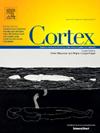Children with DCD show stronger automatic imitation effects accompanied by delayed early visual processing
IF 3.3
2区 心理学
Q1 BEHAVIORAL SCIENCES
引用次数: 0
Abstract
Children with Developmental Coordination Disorder (DCD) are believed to have impaired internal motor representations in the control and learning of movements. This study tested this hypothesis by assessing the automatic imitation effect, that relies on internal representation of movement, in children with and without DCD, using a comparison of the behavioural effect and the neural processes contributing to it. Reaction times and EEG event-related potentials were measured during an automatic imitation finger-tapping task in 36 children with DCD (age: M = 12.9 years; SD = 2.0) and 36 matched typically developing children (age: M = 12.9 years; SD = 1.9). Contrary to our expectations, children with DCD demonstrated significantly stronger automatic imitation effects than children without DCD. This was accompanied by altered neural processing, evidenced by a significant delay in the visual processing of body parts, as reflected in N190 latency. However, no differences were observed in motor preparation, as indexed by the readiness potential. These findings suggest that children with DCD do not exhibit reduced automatic imitation, and do not support the assumption of impaired internal representation of action in this group. Yet, deficits in control processes, such as alterations in the timing of perception, may contribute to the difficulties in DCD.
DCD患儿表现出较强的自动模仿效果,并伴有早期视觉加工的延迟。
患有发育协调障碍(DCD)的儿童被认为在控制和学习运动方面有内部运动表征受损。本研究通过评估自动模仿效应(依赖于运动的内部表征)来验证这一假设,在有和没有DCD的儿童中,使用行为效应和促成它的神经过程的比较。对36例DCD儿童(年龄M = 12.9岁,SD = 2.0)和36例正常发育儿童(年龄M = 12.9岁,SD = 1.9)在自动模仿手指敲击任务中的反应时间和脑电图事件相关电位进行了测量。与我们的预期相反,有DCD的儿童比没有DCD的儿童表现出更强的自动模仿效应。这伴随着神经处理的改变,身体部位视觉处理的显著延迟证明了这一点,正如N190延迟所反映的那样。然而,在运动准备方面没有观察到差异,正如准备电位所指示的那样。这些发现表明,患有DCD的儿童并没有表现出自动模仿的减少,也不支持这一群体中行为的内部表征受损的假设。然而,控制过程的缺陷,如感知时间的改变,可能会导致DCD的困难。
本文章由计算机程序翻译,如有差异,请以英文原文为准。
求助全文
约1分钟内获得全文
求助全文
来源期刊

Cortex
医学-行为科学
CiteScore
7.00
自引率
5.60%
发文量
250
审稿时长
74 days
期刊介绍:
CORTEX is an international journal devoted to the study of cognition and of the relationship between the nervous system and mental processes, particularly as these are reflected in the behaviour of patients with acquired brain lesions, normal volunteers, children with typical and atypical development, and in the activation of brain regions and systems as recorded by functional neuroimaging techniques. It was founded in 1964 by Ennio De Renzi.
 求助内容:
求助内容: 应助结果提醒方式:
应助结果提醒方式:


